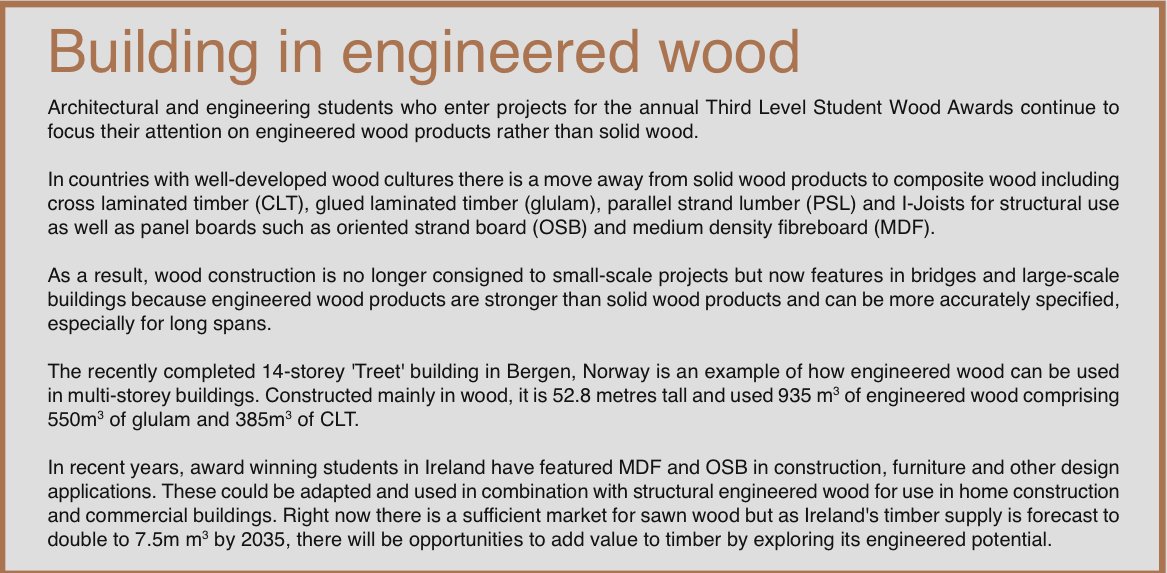Minister Andrew Doyle presents top wood awards to
Limerick, Dublin and Galway students
Most of the seven students who made the shortlist for this year’s Third Level Student Wood Awards explored traditional and contemporary timber end uses. While solid sawn timber applications formed the basis of a number of entries, today’s students are invariably attracted to engineered wood products and push timber well beyond its traditional boundaries. This approach reflects global architectural and engineering trends.
Innovative architects, engineers, wood scientists and designers are attracted to structural engineered wood products because they offer design versatility as well as the potential to specify timber for large-scale projects including bridges and multi-storey buildings as high as 53 metres.
Minister of State with responsibility for forestry Andrew Doyle presented awards in the following categories during the annual prize-giving event held in the National Botanic Gardens, Dublin:
- Engineering
- Architecture
- Craft/fabrication
- Design
“I consider this competition to be particularly significant in that it not only promotes the use of wood in the various types of applications but fosters creativity in our students and also opens our eyes to the potential of timber,” he said.
ENGINEERING
Matt Collins, winner of the engineering award, developed a project using gridshells in construction. Wood is an ideal material for gridshells. These are three-dimensional structures which derive their strength from double curvatures.
“Like shells, they can achieve large span to thickness ratios,” explained Matt, a University of Limerick student. “However, requirements including low stiffness, high strength and few defects, can result in high selection and processing costs when using solid timber,” he said. He believes that engineered timber may be a viable alternative that avoids these costs and convinced the judges of the suitability of Irish oriented strand board (OSB) for bending-active gridshells.
He developed a computational model to predict stress and load-deformation behaviour of OSB using single and double layer gridshells.”
ARCHITECTURE
Niamh Denny, Dublin Institute of Technology won the architecture award for her project “Timber Systems Through Circumstance.” She focused on the economy and evolution of timber framing systems. Niamh explored “how a simple timber structure would react and adapt to a building typology which requires private, semi-private and public spaces to be coherent throughout”.
The complex project can be adapted to a large-scale public building. “The typology chosen explores a public health centre connected to a private respite centre, using standard `off the shelf` timber and work within its restrictions and limitations,” she said.
CRAFT/FABRICATION
This is a wide ranging category but essentially rewards students who explore wood design ranging from traditional crafts to new and exciting uses whether working in sawn, recycled or engineered wood.
The outright award went to Brendan Mc Garry, Letterfrack College, Co. Galway for his project “Ch.53”. He worked to a brief that “challenged students to design and manufacture an innovative chair from wood with commercial potential for mass production”.
Through a series of tests and critical analysis, the chair was designed for adaptability to various environments and impressed the judges as it had market appeal and could be massed produced.
Two commendations were made in the craft/fabrication award to Rob Ó Foghlú, Colaiste Stiofáin Naofa in Cork for “Binse” and Shane McEvoy, Dublin Institute of Technology for “The Bureau”.
Binse is a contemporary study table, intended for light and occasional use in the modern work or living space. Inspired by traditional Japanese joinery, Rob explored both traditional and contemporary design, using high-pressure laminates with a solid wood walnut frame.
Shane McEvoy designed and manufactured a writing bureau based on traditional wood working, which meant that he had to learn a number of crafts such as veneering, marquetry and turnery.
DESIGN
The judges provided two commendations in the design category. Andrew Collins, Dun Laoghaire Institute of Further Education was praised for his project “Rove” an innovative chair made from native Irish oak. Andrew steam bent and fastened oak strips together using copper rivets. “The construction method was developed for the purposes of boatbuilding, so used the minimal amount of material to retain lightness whilst also exhibiting the strength necessary to battle the elements,” he said. The material was recycled from timber offcuts in the workshop.
The second design commendation went to Elysia Taylor, Bray Institute of Further Education for her project “Leaf Table”. The trifoliate design of the table tops references the shamrock symbol. Elysia used three timber species in her project. Ash was used in the table tops which was biscuit jointed. Walnut provided the central “dome” axis while beech was used in the legs and base.
The adjudication panel comprised Simon O’Driscoll, O’Driscoll Furniture, Guillaume Coste, Coillte Panel Products and John Winslow, Donnelly Turpin Architects. “These brought a wealth of experience to the awards which the students could relate to as all three are top professionals in their disciplines of architecture, engineering and design,” said Paul Harvey, chairman of the Wood Marketing Federation, the organisers of the event.
The awards are supported by Coillte – the main sponsor – as well as COFORD, Department of Agriculture, Food and the Marine and the Society of Irish Foresters.

![Wood marketing federation [top]](/wp-content/uploads/2023/12/wood-banner.png)














